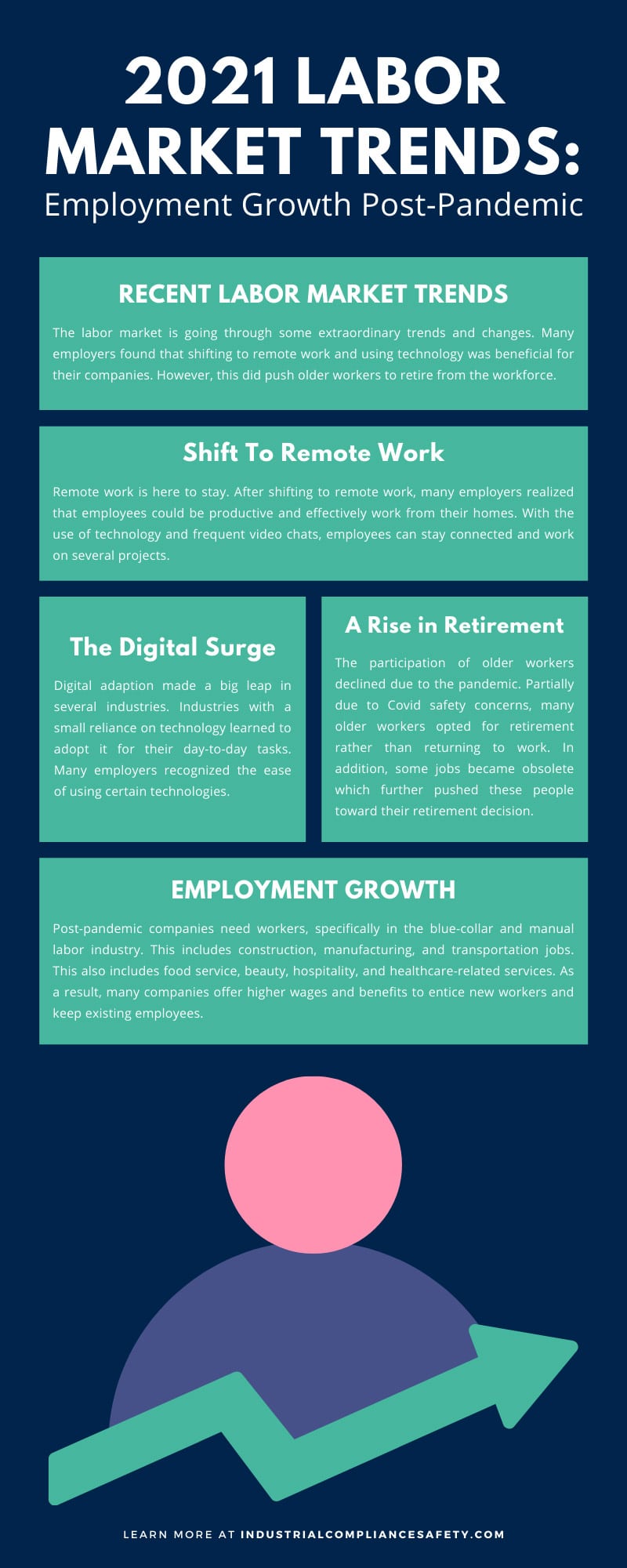The COVID-19 pandemic had a huge effect on the economy and labor market. Many people found themselves unemployed and unsure about the future of their jobs. Over time, industries began to restore and people found employment. However, there is a shift in the job market. Keep reading to explore 2021 labor market trends and learn about employment growth post-pandemic.
COVID-19 Impact on Labor Market
The COVID-19 pandemic triggered one of the worst job crises since the Great Depression. Companies, businesses, and warehouses suddenly stopped production. As a result, many people were left unemployed and unsure about the future of their jobs. On the other hand, people in specific fields like healthcare and food production found themselves working tirelessly throughout the pandemic.
Most Effected Industries
The pandemic had a huge effect on all sectors of the labor market and economy. However, specific industries such as hospitality and retail felt a direct impact. This is because government officials mandated a lockdown on the country, meaning that people were not allowed to leave their homes, be in the company of others, or gather in public spaces. As a result, there was a shutdown on industries that require the attendance of many people.
The Hardest Hit Occupations
- Service workers – food servers, janitors, security guards, and other face-to-face jobs
- Office workers – administrative assistants, receptionists, and other office employees
- Sales workers – door-to-door salesclerks, real estate agents, and financial sales agents
- Retail workers – retail store associates, cashiers, and managers
- Construction workers – project managers, suppliers, and site workers
Recent Labor Market Trends
The labor market is going through some extraordinary trends and changes. Many employers found that shifting to remote work and using technology was beneficial for their companies. However, this did push older workers to retire from the workforce.
Shift To Remote Work
- Remote work is here to stay. After shifting to remote work, many employers realized that employees could be productive and effectively work from their homes. With the use of technology and frequent video chats, employees can stay connected and work on several projects.
- Employers are expanding their employment pool. The shift to remote work allows employers to hire people from different locations outside of their business’s region. Companies can widen their employee pool by enlisting people to perform remote-based jobs without having to work in a central office.
The Digital Surge
- Digital adaption made a big leap in several industries. Industries with a small reliance on technology learned to adopt it for their day-to-day tasks. Many employers recognized the ease of using certain technologies.
- High demand for communication technology. Given that many industries went remote, the need for communication technology was at an all-time high. Technology with features like video chat, messaging, and data sharing is vital.
A Rise in Retirement
- The participation of older workers declined due to the pandemic. Partially due to Covid safety concerns, many older workers opted for retirement rather than returning to work. In addition, some jobs became obsolete which further pushed these people toward their retirement decision.
- Technology was a big concern. Another factor that’s important to note is the digital surge. Older workers may not understand new technology, making it difficult for them to perform job tasks. This factor played a part in the rise of retirement.
Employment Growth
Post-pandemic companies need workers, specifically in the blue-collar and manual labor industry. This includes construction, manufacturing, and transportation jobs. This also includes food service, beauty, hospitality, and healthcare-related services. As a result, many companies offer higher wages and benefits to entice new workers and keep existing employees.
Increase in Pay
Companies realize that the best way to bring in new employees is by offering higher pay. They also understand that they can increase current employee wages to prevent turnover. So along with a pay increase, many companies offer employee benefits like health and dental insurance to keep workers and leverage “perks” for new ones.
A Decline in Workers Willing To Do Manual Labor
Every industry is suffering from under-employment, but there is a steady decline in workers willing to do manual labor jobs. One important reason behind this decline is that the older work generation is retiring. According to CNBC, “Baby boomers that are retiring are people with less education who work these blue-collar and manual service jobs. And most of the young generation that is replacing them is more educated and less willing to work in those types of jobs.”
The Choice Is in the Workers’ Hands
Given that employers need workers, the problem isn’t “there are no jobs.” The issue is “there is no desire to perform manual labor tasks from the younger generation.” Now more than ever, employers realize that the choice is in the worker’s hands. Meaning, people aren’t competing for blue-collar and manual labor jobs.
How Can Employers Bring Back Workers?
This is a question that all employers are actively trying to figure out. Although a pay increase is a good step, there are other ways to gain new employees and keep current ones.
Ensure Workplace Safety
Ensuring workplace safety is a top priority for all employers. Whether it’s remaining remote or maintaining a hybrid work option, it’s essential to ensure safety. It’s also important in in-person industries. For example, in the construction industry, companies need specific certifications before starting a new job. Employers can get veriforce certification and other necessary paperwork prior to breaking ground. Certifications will ensure the safety of all workers and prepare everyone to work.
Adapt to the New Normal
In our post-pandemic world, it’s important to acknowledge employees’ feelings about returning to work. Employers should adapt to the “new normal” in terms of work style. If employees can perform job tasks in a remote or hybrid environment, then employers can adapt an online work presence. Companies can pair new workers with older ones for in-person industries to reintroduce social interaction and joint projects.
Rebuild Employee Engagement
Employee stress and fatigue were brought on by the pandemic. Many workers had to adapt to new working situations and found themselves feeling burnt out. As a result, it was difficult to maintain employee engagement in the workplace. Social events like happy hours, coffee breaks, and employee celebrations can rebuild employee engagement. Employers can also develop fun ways to engage with remote workers. Ultimately, it’s important to remember that workers are more likely to remain at their jobs if they’re happy.
The COVID-19 pandemic had a significant effect on the economy and labor market. Many people found themselves unemployed, but over time, some industries began to restore. However, there is a shift in the job market. After reviewing these 2021 labor market trends, we hope you better understand the employment growth post-pandemic. If you’re an employer interested in ensuring workplace safety, you should consider Industrial Compliance and Safety for your needs. From veriforce certification to safety manuals, we have everything you need. We’re here to help you demonstrate the best safety practices for employees and workers. Contact us today!






